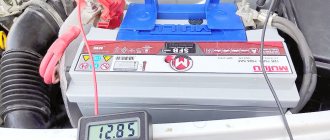The battery (rechargeable battery or battery) is one of the key components of a car. The main role of a car battery is to supply current to the starter when the engine starts. In addition, when the engine is not running, the battery ensures the functioning of various devices (lighting, sound system, signal and other current consumers). When parked, the battery powers the security system. And during a trip, when the generator cannot cope with the load, the battery comes to its aid. Normal functioning of the vehicle's on-board network is only possible with a battery that has a normal charge. Therefore, today we will discuss what the charge rate for a battery is.
Battery voltage under load
The battery voltage under load will be lower than at rest. This indicator can also be used to judge the health of the battery.
If, after connecting the load plug, the control device shows less than 9 V, then the battery is discharged and needs to be charged. If after repeating the procedure the situation does not change, the battery will need to be replaced with a new one in the near future.
If it is not possible to use a load fork to test the battery under load, then you can use a digital multimeter and turn on the engine starter as a load.
If the voltage in the on-board network drops below 9 V when the starter is turned on, then in this case you will also need to charge the battery using a charger. It is also worth checking the wiring elements and electrical consumers for serviceability.
If there is no electrical leakage in the system, and an excessive voltage drop is observed again with a fully charged battery, then the battery should be replaced.
If powerful consumers of electricity are not connected to the battery, then the voltage under light load will not change too much.
Measuring Tools
Multimeter
To measure the voltage of a car battery, you will need an ordinary voltmeter, but it is best to use a multimeter - a multifunctional device that measures direct and alternating voltage, resistance and changes in direct current.
A multimeter allows you to check not only voltage, but also current leakage. Such a device can come in handy more than once when working with electrical devices; moreover, it is inexpensive and is sold in any electronics stores.
Before taking measurements, the battery terminals will need to be cleaned of accumulated dust and dirt, and the battery itself will need to be removed from the car. All further manipulations will be carried out either at home or in the garage - wherever is more convenient.
On the multimeter, you need to enable the corresponding mode, setting the value to 20 V. Next, you need to connect the black probe to the negative terminal, and the red probe to the positive terminal. After this, the voltage value will be displayed on the multimeter screen. Nothing critical will happen if the wires are mixed up - no information will simply appear on the display.
Important! Measuring in this way will not provide information about the performance of the battery - for this it is necessary to additionally apply a load.
Battery voltage without load
The voltage of the battery, to which no electricity consumers are connected, is 12.6 - 12.8 V. If the voltage at rest is less than this indicator, this will indicate that the battery is discharged or there is a short circuit in some banks.
Operating a battery with a reduced charge level will certainly lead to the formation of lead sulfate on the plates, which will cause a significant drop in the capacity of the device.
To accurately measure the battery voltage without load, be sure to remove the terminals from the battery terminals immediately before connecting the measuring device.
Charging a battery with constant resistance
Is it possible to charge a battery with a constant resistance? From the formula I =U*R, it is clear that if you set the resistance to a constant value, then the current or voltage will become variable. But inside the battery, resistance is a variable value that affects energy absorption. The total resistance consists of the polarization resistance, which changes, and the ohmic resistance, which remains stable under the same conditions and for a particular battery.
The resistance is affected by temperature, degree of discharge, and electrolyte concentration, which are taken into account in the characteristics of the battery discharge curves. But if in the formula resistance is a variable value over time and the state of the car battery, then current, voltage, or a combination of current and voltage can be constant during charging. To smooth out the charging current, a resistor is used - ballast resistance.
Charged battery voltage
If the battery is fully charged, the voltage will depend on the battery model. If a regular antimony battery is used, then the minimum value of this indicator should be 12.6 V.
For a calcium battery, this indicator may be slightly higher, and at the terminals of a gel battery, this parameter should not fall below 13 V. If this indicator deviates from the norm, the battery must be charged with a current equal to 10% of the battery capacity.
If the battery voltage is measured while the engine is running, the readings from the device will be significantly higher. With a working battery and relay regulator, the voltage at the terminals can reach a maximum value of 14 V.
All verification methods
There are different ways to check the voltage of a car battery for its level of discharge. Let's look at them.
Multimeter
To check Akum, Vatra and other brands of batteries installed on KamAZ, Volvo, and BMW vehicles, it is convenient to use a multimeter.
Automotive multimeter
You will find the device in any specialized store; it is available at service stations. For one-time measurements, it’s easier to borrow a multimeter, although most drivers need it regularly.
Digital devices are more expensive than mechanical ones, but they are more convenient to use.
Most likely, the readings of the multimeter and the on-board computer will differ.
Standard dashboard devices often make mistakes and give an insignificant error, since they are not directly connected to the battery. Usually the deviations are on the smaller side.
With the engine running
We have figured out what voltage should be on a charged car battery, now we will consider the procedure for measuring current indicators with the engine running.
The main working tool is a multimeter.
First, take measurements with the engine running - normally the value should be around 13.5–14.0 volts.
If the value is greater than 14.2 volts, the charge is low, the generator will direct energy to charge the battery. Excessive indicators in the winter season are considered the norm in this case.
There is nothing wrong with high current. When everything is in order with the electrical equipment, after 10 minutes the electronic parts of the system will drop the current values to the standard maximum 14 volts.
In the absence of this reaction, the figure is not gradually reset to optimal values, and the battery may be overcharged. It will constantly function at maximum efficiency and the electrolyte will begin to boil away.
When the indicator is less than 13.0–13.4 volts when the engine is turned on, we can talk about the lack of full charge. Do not immediately run to the service center; first, measure the readings with the consumers turned off - this is the air conditioner, radio, headlights, cigarette lighter, etc.
A sharp drop is also possible if the contacts are oxidized - check them before going to the service center and, if necessary, clean them with sandpaper.
Another method of checking is with the power consumption sources turned off and the engine running, you should get 13.6. Check the parameters for compliance, if everything is normal, turn on the low beam, and the indicator should drop by 0.1–0.2 volts.
Now turn on music, split-system, and other energy consumers in the car. Perform the actions gradually, each time you turn on the consumer again, the parameter should drop slightly.
If there are sudden surges, most likely the problem is in the generator system - it is not working at full power, or the brushes are worn out or dirty.
Even if all energy consumers are turned on, the indicator still does not normally fall below 13 V. Otherwise, the battery will begin to discharge heavily and will run out completely.
The solution to the problem in this case is to replace the battery.
With the motor off
You will also need a multimeter to carry out the work. If the reading on the terminals is below 11.8 volts, the car most likely simply will not start; you will have to light it from another car.
The normal level with the engine turned off is 12.5–13.0 volts. A value of 12.9 indicates that the battery is approximately 90% charged, 12.5 - half charged, 12.1 - no more than 10% remaining. These are calculations by eye, but many motorists use them.
An important nuance of checking with the engine turned off is that if the engine has just been turned off, the value will be one, but the morning after it has been idle it will be different.
It is optimal to measure the voltage immediately before the trip. The battery charge level indicates its ability to hold values for several days. If the battery is fully charged and you have not driven for a week or more, the parameter will drop sharply. That is, the value is not constant.
Using a load fork
Testing the battery using a load fork is an accurate, simple and effective way to check the performance of a car battery. Eventually you will find out if the battery is charged.
Connect the plug to the correct battery terminal for a maximum of 5 seconds. At first it should be around 12–13 volts, after the fifth second it should be more than 10 volts, despite the decrease. Such a battery is considered fully charged and can operate under different loads.
When the indicator during testing when checking with a load plug drops to 9 volts, the battery is faulty, and it is recommended to replace it.
During the cold season
A decrease in the temperature of the environment causes changes in the nominal density of the working substance - the electrolyte. Taking into account the battery charge level, the reaction to low temperatures will be determined.
A fully charged battery will have a sharp increase in density, which will cause a sharp jump in measurements.
When the power supply is dead, the density decreases due to frost, and difficulties arise when starting the engine.
Drivers completely mistakenly believe that in winter the battery is further discharged due to low air temperatures. In reality, the role is played not by the low temperature of the environment, but by the slowdown of chemical processes in the battery as a result of frost.
Normal battery voltage
The normal battery voltage is an indicator that is displayed in the documentation for the power source. If, when purchasing a new battery, it is not possible to charge it to the value specified in the instructions, then such a malfunction will be a warranty case.
If the relay-regulator and generator on the car are working properly, then the battery will be automatically charged to a normal level during operation of the car. It is advisable to strive to use the battery throughout its entire service life only when there is normal voltage at the terminals.
With significant deviations of this parameter downward in the winter, the electrolyte in a discharged battery may completely freeze, and in the summer the lead plates will deteriorate more intensively.
| Charge level of antimony and hybrid batteries at voltage in Volts | |||||
| Electrolyte temperature | 100% | 75% | 50% | 25% | 0% |
| 48,9 | 12,663 | 12,463 | 12,253 | 12,073 | 11,903 |
| 43,3 | 12,661 | 12.,461 | 12,251 | 12,071 | 11,901 |
| 37,8 | 12,658 | 12,458 | 12,248 | 12,068 | 11,898 |
| 32,2 | 12,655 | 12,455 | 12,245 | 12,065 | 11,895 |
| 26,7 | 12,650 | 12,45 | 12,240 | 12,060 | 11,890 |
| 21,1 | 12,643 | 12,443 | 12,233 | 12,053 | 11,883 |
| 15,6 | 12,634 | 12,434 | 12,224 | 12,044 | 11,874 |
| 10 | 12,622 | 12,422 | 12,212 | 12,032 | 11,862 |
| 4,4 | 12,606 | 12,406 | 12,196 | 12,016 | 11,846 |
| -1,1 | 12,588 | 12,388 | 12,178 | 11,998 | 11,828 |
| -6,7 | 12,566 | 12,366 | 12,156 | 11,976 | 11,806 |
| -12,2 | 12,542 | 12,342 | 12,132 | 11,952 | 11,782 |
| -17,8 | 12,516 | 12,316 | 12,106 | 11,926 | 11,756 |
| Charge level for Calcium, AGM and GEL batteries at voltage in Volts | |||||
| Electrolyte temperature | 100% | 75% | 50% | 25% | 0% |
| 48,9 | 12,813 | 12,613 | 12,416 | 12,013 | 11,813 |
| 43,3 | 12,811 | 12,611 | 12,411 | 12,011 | 11,811 |
| 37,8 | 12,808 | 12,608 | 12,408 | 12,008 | 11,808 |
| 32,2 | 12,805 | 12,605 | 12,405 | 12,005 | 11,805 |
| 26,7 | 12,8 | 12,6 | 12,4 | 12,0 | 11,8 |
| 21,1 | 12,793 | 12,593 | 12,393 | 11,993 | 11,793 |
| 15,6 | 12,784 | 12,584 | 12,384 | 11,984 | 11,784 |
| 10 | 12,772 | 12,572 | 12,372 | 11,972 | 11,772 |
| 4,4 | 12,756 | 12,556 | 12,356 | 11,956 | 11,756 |
| -1,1 | 12,738 | 12,538 | 12,338 | 11,937 | 11,738 |
| -6,7 | 12,716 | 12,516 | 12,316 | 11,916 | 11,716 |
| -12,2 | 12,692 | 12,492 | 12,292 | 11,892 | 11,692 |
| -17,8 | 12,666 | 12,466 | 12,266 | 11,866 | 11,666 |
How to set the electrolyte level
It is possible to check the level only in serviced batteries. It is strongly recommended not to tamper with the integrity of the casing of a maintenance-free battery to perform unintended “maintenance.”
If the battery is serviceable, it needs to be removed, cleaned of dirt and the plugs unscrewed. The level is measured using a special tube with a millimeter scale. It is lowered into the jar until it comes into contact with the upper plate of the separator; the hole at the top is clamped with a finger. When pulling out, you can easily determine the electrolyte level. It should not be less than 10 mm. If the electrolyte level is less than the specified value, you need to determine the reason for its decrease. It usually falls due to normal boiling and evaporation. In this case, you just need to add distilled water to the jars.
If the level has decreased due to electrolyte spillage, you need to add ready-made electrolyte. After topping up, the battery must be recharged.
Discharged battery voltage
If the battery voltage is less than 11.6 V, then the battery is considered completely discharged. In this case, the operation of the electricity source is impossible and to restore its functionality you will need to use a charger operating from a 220 V network.
Almost all lead batteries are sensitive to full discharge. Calcium acid batteries can lose a significant part of their capacity even after a single deep discharge. The antimony device has great tolerance. Gel and AGM batteries are the most resistant to full discharge.
Visual inspection of the battery
The first thing you can do to determine whether the battery is working is to inspect it. Appearance can tell a lot.
Dirt mixed with moisture and automotive fluids on the terminals is an unacceptable phenomenon. It leads to oxidation of metal parts and loss of electrical contact. As a result, at best, we can get a self-discharge, at worst, a short circuit. If the battery is dirty, take the time to check the self-discharge current to make sure that it is necessary to maintain cleanliness under the hood. To do this, take an ammeter, disconnect the wires from the battery, touch one of the terminals with one probe, and simply run the other along the battery body. The value indicated on the ammeter screen will be the self-discharge current.
Next, take a look at the battery case. The presence of cracks and drips on it indicates mechanical damage, which caused the leakage of electrolyte. If this happens, it is no longer advisable to use this battery. When there are leaks from under the plugs, it is necessary to check the amount of electrolyte in each of the cans and eliminate the reason for its pouring out.
Battery voltage in winter
In winter, constant undercharging of the battery can lead to a significant decrease in the density of the electrolyte, as a result of which the liquid inside the cans can freeze. Freezing of the electrolyte, in many cases, leads to complete inoperability of the power source. To prevent this from happening in winter, there must be at least 12.5 V at the terminals.
If a serviceable battery model is in use, the battery charge level can be monitored without using a voltmeter. It is enough to regularly measure the density of the electrolyte, which should be about 1.28 g/cm3 for a fully charged battery.
Battery charge level table
| Electrolyte density, g/cm³ | Voltage without load | Voltage under load 100 amperes | Battery charge level, % | Electrolyte freezing point, °C |
| 1,11 | 11,7 | 8,4 | 0 | -7 |
| 1,12 | 11,76 | 8,54 | 6 | -8 |
| 1,13 | 11,82 | 8,68 | 12,56 | -9 |
| 1,14 | 11,88 | 8,84 | 19 | -11 |
| 1,15 | 11,94 | 9 | 25 | -13 |
| 1,16 | 12 | 9,14 | 31 | -14 |
| 1,17 | 12,06 | 9,3 | 37,5 | -16 |
| 1,18 | 12,12 | 9,46 | 44 | -18 |
| 1,19 | 12,18 | 9,6 | 50 | -24 |
| 1,2 | 12,24 | 9,74 | 56 | -27 |
| 1,21 | 12,3 | 9,9 | 62,5 | -32 |
| 1,22 | 12,36 | 10,06 | 69 | -37 |
| 1,23 | 12,42 | 10,2 | 75 | -42 |
| 1,24 | 12,48 | 10,34 | 81 | -46 |
| 1,25 | 12,54 | 10,5 | 87,5 | -50 |
| 1,26 | 12,6 | 10,66 | 94 | -55 |
| 1,27 | 12,66 | 10,8 | 100 | -60 |
Dependence of voltage on electrolyte density
The battery charge level directly depends on the density of the electrolyte. If the battery is serviceable, then the charge level can be measured quite accurately without using a tester.
Using a hydrometer, density is measured by taking a small amount of electrolyte from each jar of the device. The maximum density of the mixture of sulfuric acid and water in a fully charged battery is 1.3 g/cm3.
This indicator should be adhered to if the machine is operated in the cold. In summer, it can operate batteries with a density of 1.26 g/cm3 and higher. If the density of the electrolyte is within these limits, then the voltage at the terminals will be about 12.7 V. As the density drops, there is a proportional decrease in the potential difference at the battery terminals.
This indicator can decrease especially strongly if there are leaky places in the battery case through which some of the electrolyte will leak out. The electrolyte level can be restored by adding distilled water.
How many amperes are there in a charged battery?
To answer the question of what voltage the batteries should have, we need to consider the battery data, which is located on the device itself. You need to look at such important characteristics as the voltage of a charged car battery without load and the energy capacity of the device. If the voltage is 65 ampere/hour, then the battery during charging can deliver a current of 5A for 11 hours. To find out the number of amperes, you need to connect the product to the charger.
But you need to take into account that the current ratings of different batteries can vary significantly. It all depends on the additional load. The higher its value, the more energy the battery gives off. Also, the voltage on a charged car battery depends on temperature. So, at temperatures below 0˚C, the battery begins to perform its functions worse, since the rate of chemical passage decreases. reactions.
To achieve normal battery voltage under load, manufacturers began to develop technology for good contact of the solution with the plates, which are made of special materials.
How to check battery voltage with a multimeter
You can measure the operating voltage at the battery terminals using a voltmeter, which is one of the functions of a multimeter.
The battery is a source of direct current, so before starting measuring work, the device should be set to the “DC” position. You should also set the voltage limit to 20V to allow more accurate measurements.
After proper preparation of the measuring device, it will be enough to connect the black probe to the minus, and the red one to the plus of the battery, so that the device shows the DC voltage. If you mix up the probes, the value will be negative.
Still have questions about battery voltage or have something to add? Then write to us about it in the comments, this will make the material more useful, complete and accurate.
What to do if the battery charge is not normal?
The answer to this question is simple. If the battery charge is not normal, the battery needs to be charged. The charging process was described in detail in the article “How to properly charge a car battery with a charger.” Here I would like to note some nuances.
Charger
There are three main types of charging:
- accelerated This mode is often called Boost and can be found on many modern chargers (chargers). In this mode, the battery charge is not fully charged, but it is quite enough to start the engine. This type of charging is used when you need to go urgently and the battery is low. This mode is not recommended to be used continuously. Here, the charge is accelerated by increasing the current strength, which increases the battery life;
- with constant voltage. This type of charging involves maintaining a constant voltage across the terminals. This mode is used in the automatic charge mode on most chargers. It is recommended to use it when the battery is not very discharged (not lower than 12 volts). Read more about car battery voltage in the article at the link. The advantage of this mode is that you don't have to control it. The charger itself will determine when the charge is normal and stop the process;
- with direct current. This charging option involves supplying constant current to the battery. The process is carried out in several stages, in which the current gradually decreases. This mode is recommended when charging a deeply discharged battery. It allows you to charge the battery most fully and evenly. The downside is that you will have to constantly monitor the process, measure the voltage and stop the process when the battery charge is normal.
Battery charging process
In conclusion, I would like to remind you about the safety rules when charging a battery. The process must be carried out in a ventilated area. It is better not to charge in residential areas. There should be no open flames or sparks near the battery being charged. During the charging process, hydrogen is released, which in combination with oxygen forms an explosive mixture!
We also recommend reading the material about how much a car battery weighs.
How to correctly measure the voltage on the battery and in the vehicle’s on-board network
Let us repeat that the battery voltage is an indicator of its operating condition. There are several ways to measure it:
- using a multimeter or voltmeter;
- using a load fork;
- measuring the density of the electrolyte.
Next, we will consider each of the listed options in more detail.
Multimeter or voltmeter
To measure the voltage on the battery, many use a simple and very long-used, and therefore proven, method - using a multimeter. This device allows you to make measurements with an accuracy of tenths and even hundredths of a volt.
Important! To obtain reliable results, it is necessary that 4-5 hours have passed since the last charge or discharge. During this time, the voltage stabilizes.
To measure, switch the multimeter to constant voltage measurement mode and the measurement limit closest to 12 V, usually 20 volts, designated “20 DCV”.
If there is a need to more accurately measure the battery charge level, you will have to use special chargers that have memory and a microprocessor. With their help, it is possible to track and compare not only the discharge process, but also the normal charging of the battery over a certain number of cycles.
Checking and measuring with a load fork
The essence of this method of checking the normal battery voltage is extremely simple - measurements are made under load, which allows you to accurately assess the condition of the battery.
To make it clear, let's look at an example. If a battery with a capacity of 60 Ah is checked, then the minimum load should be 120 A. It is applied for 3-5 seconds. More information on using the load fork can be found here: .
Electrolyte density measurement
For vehicles that have serviceable batteries with liquid electrolyte, the state of charge can be determined by measuring its density. The relationship between these parameters is clearly shown in the table below.
| Charge level (%) | Electrolyte density (g/cm3) |
| 100 | 1.266 |
| 95 | 1.258 |
| 90 | 1.250 |
| 85 | 1.242 |
| 80 | 1.234 |
| 78 | 1.226 |
| 70 | 1.219 |
| 65 | 1.212 |
| 60 | 1.205 |
| 55 | 1.198 |
| 50 | 1.191 |
| 40 | 1.177 |
| 30 | 1.163 |
| 20 | 1.149 |
| 10 | 1.135 |
To be fair, it should be noted that the information contained in the table is valid for batteries used in the middle zone. Depending on climatic conditions, the normal density varies:
- 1.27-1.29 g/cm3 - for cold regions, and at any time of the year;
- 1.25-1.27 g/cm3 - as we have already said, for the middle band;
- 1.23-1.25 g/cm3 - places with high average annual air temperatures.
For your information! Density checks are carried out once every 3 months. Even minor deviations from the norm are unacceptable.
Why did the battery die?
A common and annoying reason is that you forgot to turn off the lights or lights in the cabin. Although on modern models there is no need to be afraid of this - after some time after turning off the engine, the automation de-energizes all energy consumers. Sometimes energy is sucked out of the battery by incorrectly connected “car music” and other non-standard consumers: alarms, seat heating, cameras and other equipment.
With the onset of cold weather, the battery is more likely to discharge for another reason. In winter, starting currents increase sharply: the starter requires more energy to rotate the crankshaft in thickened oil. In addition, in the cold the battery (even a new one) does not accept a charge well. As a result, after each short trip the battery is gradually discharged until it “goes to zero” completely.
Is it possible to start a car with a cordless screwdriver?
This method is adventurous. And it’s applicable when there are no other options left—there’s no charged battery at hand, no booster, no one has a “light.”
We remove the battery from the screwdriver, attach suitable contacts, and attach it to the standard battery terminals of the car. Don't get your hopes up: the starter won't even twitch. The only thing you can count on is to push the car. Perhaps the screwdriver battery has enough energy to revive the motor.
To light the cigarette, you can use a cordless screwdriver or impact wrench. Only the voltage of its battery should not be higher than 14 V.
To light the cigarette, you can use a cordless screwdriver or impact wrench. Only the voltage of its battery should not be higher than 14 V.
Important:
Be sure to check the supply voltage of the screwdriver. If 12 or 14 V, connect safely. And with 18-volt it’s not even worth trying. We conducted an experiment: we tried to start the car with an 18-volt lithium-ion battery. To reduce the voltage at least a little, the headlights were turned on before connecting the screwdriver battery. The engine was started from the pusher, but the lamps in the headlights burned out. But a more important and expensive part could have burned out!











